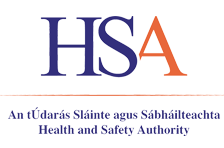Danger Associated with Electrical Cable Reels
Following a number of recent incidents, including electrocutions, where electric cable reels were involved, the HSA wishes to warn people of the dangers that could arise from the misuse or abuse of electric cable reels.
The danger arises principally from
- overloading,
- overheating due to the cable reel being coiled up while powering equipment or
- lack of structural integrity of the cable or reel allowing access to uninsulated live parts of the cable or
- connections
Picture 1: Results of overheating in cable. (This may not be evident until the cable is unreeled).
 |  |
Overloading & Overheating
When power flows through an electrical cable, some heat is always generated in the cable. This heat generally dissipates into the air. If the reel is left coiled during use, the heat generated in the cable may not dissipate and can start to build up. This in turn can melt the outer insulation of the cable and the insulation on the cores, leading to earth cores and neutral cores becoming electrically live. In this situation a very serious risk of electrocution arises for anyone using an appliance fed through the reel or indeed for anyone touching any piece of metal in the vicinity.
Damage to Cables or Reels
Other issues arise when the insulation on the cable becomes frayed and exposed. This can be caused by trapping or damage to the cable as it goes through doors and windows, or when it is walked or driven on. Internal wires can be exposed and damaged with the risk of electrical shock and electrocution on contact.
Picture 2 Damaged cable Insulation on cable reel giving rise to risk of electrocution |
|
| In addition, if the reel itself is broken or damaged, people may be electrocuted by touching live connections or other live parts within the reel. |
Precautions
To avoid the risks associated with this hazard, the following precautions should be in place.
Earthing
Ensure your electrical installation is adequately installed and earthed. Look out for scorch marks on electrical fixtures such as sockets and switches or for damaged or frayed cables. If in doubt, a competent electrician should inspect and test the installation to ensure its safety.
RCD Protection.
Ensure the cable reel, and all circuits fed via cable reels, are protected at source by a functioning residual current device (RCD). These RCDs are generally located in your electrical distribution board and should be tested frequently (at least twice per year) by pressing the test button.
Picture 3 Two different types of Residual Current Devices including the test buttons.
|  |
Protection against Overload and Overheating.
Ensure that, if any significant load is being fed from the reel , that the reel itself is unwound while safeguarding against any resulting trip or entanglement hazard.
Compliance with Standards.
All reels should comply with the relevant European Standard, “EN 61242:1997+A1:2008 Electrical Accessories. Cable Reels for Household and Similar Purposes” or “EN 61316 Industrial Cable Reels”.
In addition they should be marked with a CE mark indicating compliance with the European Low Voltage Directive of 2006 (and any other applicable European directives).
Compliance with the standard ensures that the reel is adequately constructed and is fitted with a thermal cut-out or weak link which will trip the supply from the reel in the event of an overload.
Picture 4 CE Marked Cable Reel with thermal overload cut-out.
 |
Conclusion.
When using cable reels, ensure they
- are only used as intended,
- are physically protected from mechanical damage and,
- have adequate protection against overloading or overheating.
In addition the overall electrical installation must be safe and adequately earthed with the cable reel and anything fed through the reel protected by a residual current device (RCD).
April 2014

